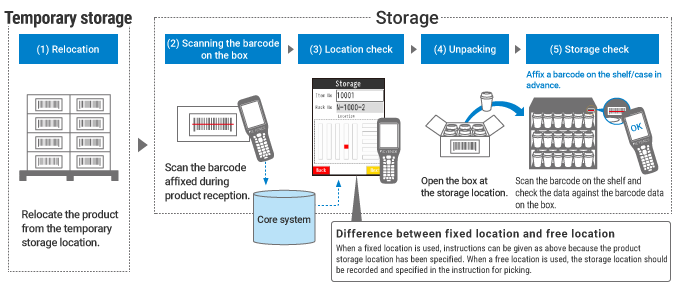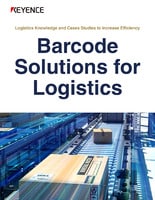Allocation
In logistics, allocation is the process of putting goods into inventory or simply storing them. Allocation is not simply storing goods. It involves inspecting the received goods and putting them on the prescribed shelf in order to facilitate effective picking and shipping from inventory. Mistakes in allocation lead to mistakes in picking and shipping from inventory, as well as lost time, so performing allocation accurately is important. This section gives problems and issues in allocation, as well as case studies that resolve these issue and make work more efficient.
Allocation Methods
Location Management
Received goods are moved to a temporary storage area after the receiving inspection and then stored on the specified shelves. This series of processes is called allocation. What is important in allocation is appropriate inventory management so that goods do not run out and there is no excess inventory. Accuracy is required in allocation so that mistakes do not occur in the subsequent processing of picking and shipping from inventory.
This is because it takes time to check the inventory area if the goods are not stored in the proper location and there is a risk of sending the wrong goods to be shipped. To prevent these kinds of problems, the most important thing is to arrange the position between goods and shelves so they can be understood at a glance. This is called location management in logistics.
Fixed Location and Free Location
There are two types of location management methods: fixed location and free location. Fixed location is a method in which the shelves that goods are placed on is determined in advance. Free location is a method in which goods are stored in free space and racks in succession and the position and other information are managed by computer.
Advantages and Disadvantages of Fixed Location
The relevance between shelves and goods and the position are clear, so the advantages are that goods are easy to find and lack of inventory can be seen at a glance. However, wasted space occurs easily because shelves are required for each good, which is not the best method from the standpoint of storage efficiency.
Advantages and Disadvantages of Free Location
Unlike fixed location, inventory can be stored in free shelves in succession, so storage efficiency is high and goods of different types can be received in succession and handled flexibly. The advantage that this method allows for first-in first-out management cannot be overlooked. However, a disadvantage is that shelves are not fixed, so one type of good may exist in multiple storage areas which makes picking work inefficient.
Problems with Conventional Methods
Low Work Efficiency with the Free Location Method
The free location method that allows the efficient use of limited space is ideal. But when compared to the fixed location method in which a relevance is made between shelves and products as described above, a drawback is that it can easily take an excess amount of time to find products. To overcome the disadvantages of the free location method and maximize its advantages, an inventory management system must be created, but this also brings up issues of cost.
Management of Products without Barcodes
If there are no barcodes on products and packaging during receiving, allocation work will become inefficient and accuracy will be lacking. The result is mistakes in the later processes of picking and shipping and a decrease in work efficiency.
Case Studies for Handheld Computers
This section introduces case studies using handheld computers that solve issues and problems in allocation. Using handheld computers is effective for reducing allocation mistakes and it leads to efficiency which also reduces time and costs.
Increase Work Efficiency Using Handheld Computers and the System
Acquiring storage areas and improving storage efficiency are issues at warehouses and logistics centers. The free location method in which goods can be stored on free shelves in succession is ideal in this regard, but work efficiency can fall if there are inventory management problems. To improve both storage efficiency and work efficiency, handheld computers must be linked to the system. If handheld computers are adopted and product information is linked to shelf information, the allocation area can be provided to the worker by simply scanning the barcode with the handheld computer and allocation can be checked at the same time to make work faster and more accurate.
Higher Efficiency in Allocation Work by Giving Products Barcodes in Receiving
Management becomes easier and allocation work more efficient by giving barcodes to products in the receiving inspection process that lack barcodes during receiving. With handheld computers, you can easily link to the system and simultaneously perform the receiving check, update inventory, and issue a barcode label to dramatically speed up the series of work from temporary product storage to allocation. And if the same barcodes are applied to the cases and racks at the same time as allocation, the allocation check (data verification) can also be performed easily.
- Flow of Allocation Work Using Handheld Computers






